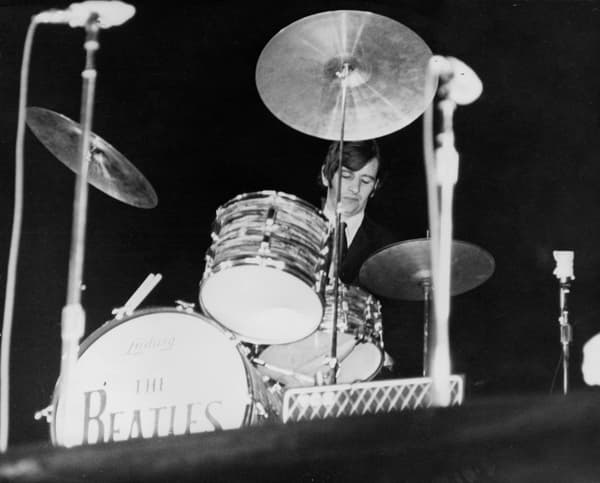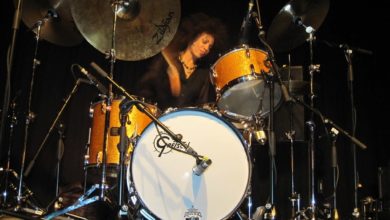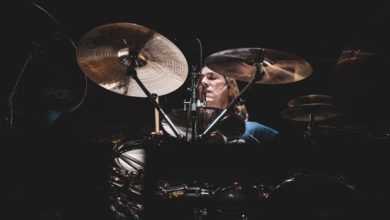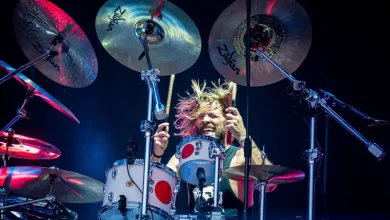
The 1960s spawned many genres and featured innovative artists. Live drum performances reached new heights in the 1960s, with drummers eager to show off their skills. This era produced many notable players who still influence modern music. In this article, we honor ten legendary drummers from the swinging sixties who inspired later generations. Let’s celebrate these icons by revisiting some great grooves!
1960’s: Culture and Music
Between the growing counterculture, the Vietnam war, the rise of feminism, and the increase in environmentalism, a lot of strong feelings arose. From the 1960s to the 1970s, music underwent just as many changes as society did.
Percussion in the early 60s was relatively mild — drums held down the fort but never got too boisterous. Back then, drum kits were recorded with just one or two microphones, and multi-tracking was very rudimentary. But as we made our way to the mid-60s and seventies, drummers got more brazen, the culture shifted, and technology was beginning to change.
Music enthusiasts have coined the term ‘The British Invasion,’ which happened in this era — English musicians began receiving a massive spotlight from audiences across the pond.
As I go through some of this era’s most famous drummers with you, notice how many of them of British and the increase in musical intensity as we get closer to the next decade!
Hal Blaine (Wrecking Crew/Session Musician)
Hal Blaine is one of the best-known drummers from the ’60s — for a good reason! He was in dozens of top 40 tracks and worked with artists such as Frank Sinatra and the Beach Boys.

However, Blaine’s claim to fame is being the most recorded session drummer ever. According to his Google profile, he partook in over 35,000 sessions and was in over 6,000 tunes, 150 of which were top 40 hits.
Hal Blaine was a rock and roll drummer who everyone has heard- But he more than dipped his toes into jazz and pop with his recordings with The Ronnettes, Herb Alpert, and many more.
Fun fact: His iconic rhythm in The Ronnette’s “Be My Baby” was a mistake. But now, that BOOM boom-boom *chick* pattern can be heard everywhere.
“That famous drum intro was an accident. I was supposed to play the snare on the second beat as well as the fourth, but I dropped a stick. Being the faker I was in those days, I left the mistake in, and it became: “Bum-ba-bum-BOOM!” -Hal Blaine, The Guardian
Though this 1964 tune was wildly popular, the demand for Blaine’s work and his fame rolled into the ’70s and 80’s with songs like “Jose Cuervo” and “For All We Know.”
Ringo Starr (The Beatles)
Ringo Star was born to the name Sir Richard Starkey in 1950 in Liverpool, UK. Everyone knows Ringo for being the Beatles drummer — But did you know that he was also a member of a group called the Hurricanes? Ringo Stars’ career as a drummer began with the pop-rock-and-rollers (Rory Storm and the Hurricanes) in the early 1960s.

While Ringo takes a lot of grief from music critics (ever hear that line about him not being the best drummer in the Beatles?!), he’s still one of the richest drummers in the world. Ringo was never a super technical or flashy player, but his tracks were catchy and contributed to making the Beatles so iconic!
“Can’t Buy Me Love” is a tune Ringo tracked and is still one of my mom’s favorites. We also can’t forget the finesse and locked-in rhythm in “Come Together.”
Fun fact: Ringo was a left-handed drummer who played a right-handed kit. He also wasn’t the only drummer who played with the Beatles.
Keith Moon (The Who)
Keith Moon was an English drummer from Wembley, UK. He played bugle as a young kid and later learned the drums. To say Keith Moon’s playing is unique would be a fast understatement.

Moon was described as both ‘manic’ and ‘hell-raising’ in an article penned on LouderSound. Keith Moon was not only an iconic percussionist but also had a playful, mischievous personality. He put cherry bombs and dynamite in toilets, plastic spiders in people’s bedsheets, and other wild things.
He was known as ‘Moon the Loon’ because his playing was as crazy, fun, and childish as his pranks. He was innovative and didn’t feel the need to play a tune the same way twice. Keith Moon played with The Who for a decade and a half.
Unfortunately, drug addiction took Moon for the world far too soon — he passed away in his early thirties. However, his legacy and influence live on. Musicians like Neil Peart (Rush) and Roger Taylor (Queen) cited being influenced by the chaotic, magnetic drummer.
Catch some of Moon’s personality and unconventional playing in the promo video here.
Charlie Watts (Rolling Stones)
Charlie Watts was an English drummer and member of the Rolling Stones. He first began drumming in his mid-teens when he received a snare drum for Christmas.
Later, he borrowed a drum kit and began learning well-known tunes. The Guardian described Watt’s personality as ‘dapper and deadpan,’ which is a fun alliteration and an unusual way of penning a person. Like Ringo, Watts wasn’t flashy or bold but is often described as ‘unshakable.’
Watt’s background in Jazz and Blues shined through in his playing with the Rolling Stones. Watts often played traditional grip in the first half of the 60s, which is interesting because most kit players used matched. He also used traditional grip here, in this video from 2008.
John Bonham Aka ‘Bonzo’ (Led Zepplin)
John Bonham was a lightning-fast drummer from Redditch, UK. And forget the double kick! John Bonham only used one bass drum. He was known for his uber-fast footwork — with just a single pedal. He hit the drums brazenly, usually with much force: subtlety wasn’t his thing.
Led Zepplin didn’t come in until 1969, but I thought I’d add Bonham as an example of just how fierce things got in the late 60s. Some even say Led Zepplin helped set the stage for metal.
Bohnham was a Ludwig diehard and always used the brand after a recommendation from Carmine Appice. Unfortunately, the drummer died of alcohol poisoning/aspiration at 32. The band was devastated when he passed and disbanded for several months after their loss.
Carmine Appice (Cactus, Vanilla Fudge)
While we’re on the topic of the late ’60s, I thought I ought to mention Carmine Appice. Appice is most well known for his work in the psychedelic rock band Vanilla Fudge. Appice and another Vanilla Fudge member formed the blues band Cactus after the band broke up.
Like Bonham, Appice went heavy on the set. He was inspired by jazz drummer Buddy Rich. It is worth noting that he is integral not only to psychedelic rock but also to the world of music education. He wrote several rock drum methods to make rock beats accessible to learn. Appice lives in New York and is still actively recording and performing today.
Bernard (Buddy) Rich
It’s hard to classify Buddy Rich as just 60’s drummer, as his career lasted for decades. But alas, the ’60s were one of the decades he was killin’ it in! Buddy Rich is an American drummer and conductor from Brooklyn. He is one of the most renowned jazz artists ever, often cited as the best jazz drummer ever.

According to his bio on Britannica, he began drumming and dancing at 18 months old. He gained the nickname ‘Baby Traps, the Drum Wonder’ after performing in his parent’s vaudeville acts. The Buddy Rich Big Band, which he started in the 1960s, was one of his longest-lasting gigs. He also collaborated with big-name jazz cats like Charlie Parker!
Honey Lantree (The Honeycombs)
Honey Landtree was born in Hayes, UK, in the 1940s and was a part of the Brit-beat group called the Honeycombs. With the Honeycombs, Honey Lantree delved into uncharted territory — She was one of the only female drummers in the 1960s. While she isn’t nearly as well known as Ringo Starr or Keith Moon, she pushed the boundaries of what a female musician ‘could and could not be’ during this relatively strict period.
Honey Lantree was a natural when it came to the kits, even though it wasn’t her first instrument. By the time they topped the charts with “Have I the Right,” Honey had begun making headlines for her drumming. Look how contagious and catchy her musicality and personality are!
Mitch Mitchell (Jimi Hendrix)
Mitch Mitchell was an English rock and drummer known for playing in Jimi Hendrix. He used a 1967 Ludwig that still makes ‘must see’ drum kit lists today. His style ranged from relaxed and groovy to improvisational, head-turning fusion.
There is quite a stir as to whether John Bonham (Led Zeppelin) or Mitch Mitchell (Jimi Hendrix) was a better drummer. Mitchell’s rock drumming was heavily infused with jazz, whereas Bonham’s was more technical, speedy, grittier, and funkier.
Ginger Baker (Cream)
Ginger Baker of Cream is still cited as an inspiration to drummers today. I wrote a press release for a musician who cited Baker the other day! And it’s no wonder why: His fusion style that blended traditional rudiments with African rhythms and jazz is purely quintessential. Baker is one of the greatest rock drummers of all time.

Ginger Baker was an English drummer born in 1939 in London. While on this 60s list, he was as much of a 60s drummer as a 70s drummer. Baker was a pugnacious musician, playing with a heat that led him to collaborate with punk musicians.
Listen to Ginger Baker share his drumming wisdom at a 1968 drum clinic here.
More ‘60s Drummers
Want to delve into some more ’60s drummers? Then check out:
- Michael Shrieve (Santana)
- Mickey Hart (Grateful Dead)
- Spencer Dryden (Jefferson Airplane)
- John Densmore (The Doors)
- Art Blakely (jazz drummer/bandleader)
60s Drummers: Final Thoughts
The 60s’ great drummers gave us grooves that will shape music for decades. From John Bonham to Ginger Baker, these legendary drummers showcased percussion’s potential. Group collaborations shine through their complex drum parts and solos. As we celebrate past and present techniques, we must remember those who revolutionized the drums in the 1960s. Which 60s drummer is your favorite? If we missed them, please comment!



